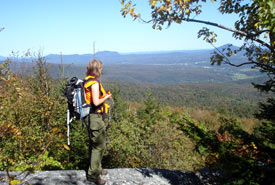Appalachian mixed forest

Mount Burnt property, Northern Green Mountains, QC (Photo by Appalachian Corridor)
In the late 19th century, on an expedition along Slide Mountain in the Catskills, ornithologist Eugene Bicknell made a discovery: a small, olive-brown thrush slightly smaller but remarkably similar in appearance to the gray-cheeked thrush. The bird was given the ornithologist's name in honour of his discovery. Today it is known as the Bicknell's thrush.
Bicknell’s thrush has become one of the most threatened nesting bird species found in eastern North America. According to the Cornell Lab of Ornithology, the species has "one of the most restricted breeding and wintering ranges of any North American bird."
In Quebec, the Nature Conservancy of Canada (NCC) has protected nesting grounds for the Bicknell's thrush in parts of the Appalachian region, including the Northern Green Mountains Natural Area.
The Appalachian region is an extension of the Green Mountains of Vermont. It is one of the last regions of southern Quebec where there are still large stretches of wilderness. This forest range is a complex of natural habitats, including wetlands of exceptional ecological value. A wide variety of flora and fauna and beautiful old-growth deciduous hardwood forests are also found here.
Ecological significance
The Northern Green Mountains Natural Area, part of the Northern Appalachians and Acadia ecoregion, extends over 3,116 square kilometres. It links up with the Green Mountains of Vermont, and is one of the last regions of southern Quebec where extensive wilderness tracks remain relatively intact.
The region provides valuable habitat for close to 60 species at risk. It is also treasured for its many lakes and important wetlands, which are unrivalled anywhere in the Canadian portion of Appalachian range. Its jagged topography gives rise to rocky cliffs and outcrops, caves, gorges, waterfalls and a multitude of permanent or intermittent streams. All of this contributes significantly to the natural area’s enrichment.
Species
The vast areas of unfragmented forests in the region play an important role for species that depend on large wilderness areas for their survival, such as bobcat and moose.
The area also contains important interior forest habitat for many forest bird species. Many of these are considered a high priority by the North American Bird Conservation Initiative, including:
- wood thrush
- veery
- black-throated blue warbler
- golden-winged warbler
- American redstart
- chestnut-sided warbler
- olive-sided flycatcher
What is NCC doing to help protect this forest?
NCC has been working here over the last 10 years to maintain large forest blocks that are able to sustain the area’s wildlife population. The Mount Burnt property is adjacent to the Long Trail and protected areas in Vermont. It also offers a great view of the Sutton Mountains — the largest private Nature Reserve in eastern Canada, which was also protected by NCC.
NCC has protected the Mount Burnt, Mount Foster and Malbaie River properties in Quebec, in collaboration with TD Forests.




